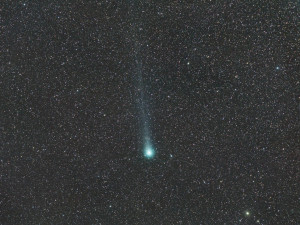NASA writes about a new report from French scientists on observations made of Comet Lovejoy as it passed around the sun early this year:
“‘We found that comet Lovejoy was releasing as much alcohol as in at least 500 bottles of wine every second during its peak activity,’ said Nicolas Biver of the Paris Observatory, France, lead author of a paper on the discovery published Oct. 23 in Science Advances.”
Here’s the first part of the NASA news release. Cheers!
Researchers Catch Comet Lovejoy Giving Away Alcohol
Comet Lovejoy lived up to its name by releasing large amounts of alcohol as well as a type of sugar into space, according to new observations by an international team. The discovery marks the first time ethyl alcohol, the same type in alcoholic beverages, has been observed in a comet. The finding adds to the evidence that comets could have been a source of the complex organic molecules necessary for the emergence of life.
“We found that comet Lovejoy was releasing as much alcohol as in at least 500 bottles of wine every second during its peak activity,” said Nicolas Biver of the Paris Observatory, France, lead author of a paper on the discovery published Oct. 23 in Science Advances. The team found 21 different organic molecules in gas from the comet, including ethyl alcohol and glycolaldehyde, a simple sugar.
Comets are frozen remnants from the formation of our solar system. Scientists are interested in them because they are relatively pristine and therefore hold clues to how the solar system was made. Most orbit in frigid zones far from the sun. However, occasionally, a gravitational disturbance sends a comet closer to the sun, where it heats up and releases gases, allowing scientists to determine its composition.
Comet Lovejoy (formally cataloged as C/2014 Q2) was one of the brightest and most active comets since comet Hale-Bopp in 1997. Lovejoy passed closest to the sun on January 30, 2015, when it was releasing water at the rate of 20 tons per second. The team observed the atmosphere of the comet around this time when it was brightest and most active.

